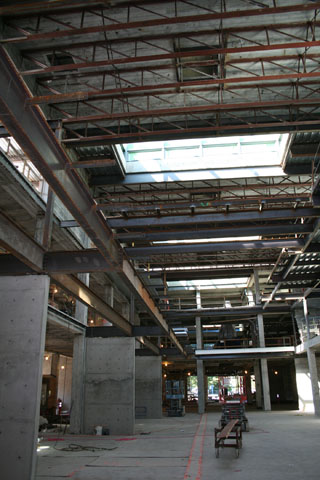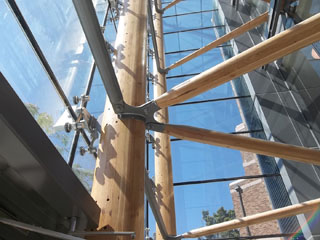|
Subscribe / Renew |
|
|
Contact Us |
|
| ► Subscribe to our Free Weekly Newsletter | |
| home | Welcome, sign in or click here to subscribe. | login |
Construction
| |
 |
September 14, 2012
Reusing HUB structure saves money and history
Coughlin Porter Lundeen

Hitzemann
|
At the outset of design for the University of Washington’s Husky Union Building modernization project, a number of schemes were evaluated that would save all, some or none of the existing building structure.
After carefully studying the options, the team decided the right choice would be to keep the majority of the structure to retain the building’s historic character, control costs and preserve its embodied energy in alignment with the project’s sustainability goals.
The structure would be demolished or rebuilt only where it compromised the layout of the new spaces or where renovations proved to be cost prohibitive. Saving the building would be no simple task, though, due to very tight floor-to-floor heights and close column spacing in much of the building.
The existing structure was composed of a variety of concrete and steel framing systems built over a number of phases from 1949 through 2001. While the building was in good condition, it had never received a comprehensive seismic upgrade over the course of these many additions.
As part of this project, the team was tasked with bringing the building up to today’s life-safety standards. Seismic upgrade work included new concrete shear walls at select locations, shotcrete strengthening of other existing walls, and new steel drag struts where necessary to tie the various components together.
The key was finding creative ways to minimize the use of new shear walls while also allowing removal of some existing walls, so the final interior layout would be open and flexible.
Light-filled space
A major goal of the project was to design a new multistory circulation spine and atrium space through the center of the building to create an inviting sense of place.
This was accomplished first with precise, surgical removal of a significant swath of the second, third and roof levels, right through the center of the building. Steel framing was then added back to create walkways, bridges, skylights and highly customized circulation stairs that connect the multilevel atrium. The result is a dramatic light-filled space carved into the heart of the building.
Another significant project goal was to relocate one of the two main ballrooms to the opposite corner of the second floor to improve the functionality of the spaces.
Needless to say, moving a 150,000-cubic-foot room within the building cannot be done without some significant impacts to the structure. A portion of the existing third floor and roof were demolished and the second floor was expanded to accommodate the new two-story south ballroom.
Next, after careful analysis, it was determined the existing structure could support the weight of a new third floor inserted into the vacated ballroom space to capture additional usable area, albeit with a pretty low ceiling due to the depth of the original roof trusses that remained.
In the end over 400 tons of structural steel were added to the building for seismic strengthening, floor infills, reframing of areas that could not be preserved, and other miscellaneous improvements.
Simplified seismic system
Early in the design phase it had been assumed that the shell of the original auditorium space at the south end of the building would be retained, and the raised sloped seating floor structure would be removed.
It became apparent that retaining this shell was not ideal due to significant seismic irregularities and other constraints. An alternative was designed that replaced this area with a light-framed custom steel-and-timber structure.
This system allowed us to also simplify the building’s seismic system significantly in adjacent areas, resulting in the construction of a new light-filled custom space at an actual net savings of $1 million.
Jewel boxes
The two new glass-enclosed, three-story “jewel box” entries were an inspirational design element to add to the project.
The entries are framed primarily with sculpted glu-lam members supporting the glass wall, roof and entry canopy panels. The elliptical-shaped columns and tapered brace and canopy beam elements required precision construction.
The glu-lams were fabricated in British Columbia through the use of North America’s largest five-axis computer-controlled milling machine.
Lean principles
The UW Capital Project Office has been pursuing ways to incorporate lean design and construction principles within the limitations of the general contractor/construction manager delivery model.
For the HUB renovation it was recognized that routing entirely new mechanical and electrical systems through the existing building would be very challenging given the low 11- to 12-foot floor-to-floor heights.
Due to the complexity of the various structural systems in the building, Coughlin Porter Lundeen produced a detailed 3-D building-information model of the structure. The model was then turned over to Skanska, the GC/CM, for their coordination with mechanical and electrical subcontractors, who produced detailed 3-D models of their systems prior to fabrication and installation.
In addition, a mechanical detailer was hired to model key areas where extreme congestion was identified during the design phase, and these models incorporated into the bid documents. Skanska believes the early modeling efforts turned out to be very successful in streamlining coordination and construction efforts in these key areas and limiting potential change orders.
On future projects UW would like to build on these lessons and find ways to further the use of lean principles to streamline construction efforts.
The design and construction work on the HUB modernization has stretched over the past five-plus years.
While it has been a very challenging and intense project, the reward is seeing the finished product and the university community’s reaction to their impressive new facility. The building was in dire need of a makeover, both to improve its functionality and to address seismic concerns.
The new, revitalized HUB will now be much better suited to serve its purpose as the student nerve center for this world-class university.
Cory Hitzemann is an associate principal at Coughlin Porter Lundeen.
Other Stories:
- HUB gets a reboot for the 21st century
- A renovation that also keeps the past alive
- HUB rehab goes beyond the walls




